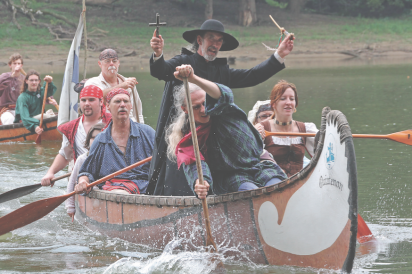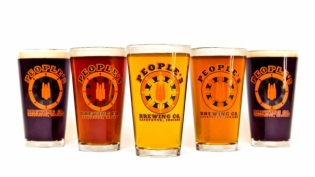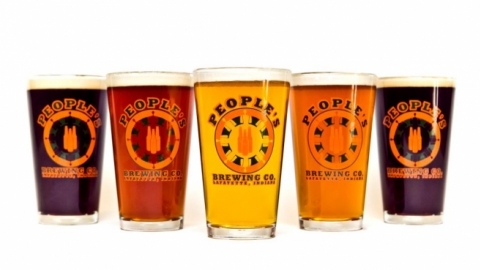The Feast of the Hunters’ Moon
Bringing History to Life on the Banks of the Wabash
In 1717, the French government established Fort Ouiatenon on the banks of the Wabash River in Lafayette. Now, almost 300 years later, it is the site of the Feast of the Hunters’ Moon, a festival that re-creates 18th century fall fur trade gatherings between Native Americans and the French. Organized by the Tippecanoe County Historical Association, on average it attracts 40,000 people and has evolved into a highly anticipated annual event celebrating the spirit of cultural exchange. The Hunters’ Moon refers to the Miami calendar and is typically scheduled on the first weekend of October. This year “The Feast,” as it is locally known, is scheduled for October 1 and 2.
I met with The Feast coordinator Leslie Martin Conwell, who spoke of the event’s almost 50-year history. She explained the important role of local nonprofit organizations, the extensive guidelines involved in setting up the food booths, as well as the archeological content of the site that was excavated between 1968 and 1979 under the guidance of archeologists from Indiana University and Michigan State University. Recovered artifacts include china, jewelry, metalwork, animal bones, seeds, utensils, pottery and more. There is still much to be learned about this period of European and Native interaction from Fort Ouiatenon since less than one tenth of the site has been excavated. By inviting the community to share in local history, the Tippecanoe Historical Association draws from an archeological depth and aims to build a collective future based on complex lessons of trade and strife. Local nonprofits that run the booths represent a wide range of community services, age groups and educational commitments. These social, historical and gastronomic convergences make local history an evolving story, Conwell says: “The Feast acknowledges that culture is ongoing.”
For me, at least three reasons make The Feast a worthy fall road trip:
Reason number 3: History
The living history and staging of The Feast help us imagine a time when Native American tribes—like the Potawami, the Miami and the Shawnee—interacted with the French. The food, clothing and traded goods help re-create a bustling atmosphere of welcomed commerce. Today, it is difficult for us to see the importance of Lafayette as a shipping center and the Wabash River as a major trade route connecting the state within and beyond. At The Feast we can gather ourselves back on the banks of the Wabash like all who traded in this area before us. We look for the same things they did: something useful, pretty or tasty. The event reminds us that, like those who lived here in the past, we make our story every day through what we buy, eat and share with each other, and history is not limited to explosive decisive battles. It makes me wonder who will be gathering at the site 300 years from now—and, of course, what will they eat?
Reason number 2: Community
While we might imagine the community that converged on the banks of the Wabash 300 years in the past and the community that might gather in the future, it is contemporary community that is most celebrated at The Feast.
When talking about the event, coordinator Conwell is clearly most proud and excited about the over 50 nonprofits that help host The Feast. For many of these organizations, this event is their primary means of annual fundraising. The period food represents not only historical relationships, but also the web of organizations that serve and shape Tippecanoe County today. Conwell pointed out numerous instances of local support that makes the event possible. For example, local church groups stepped in and volunteered to drive the buses between the Purdue parking lot and the site after the previous service fell through. And, and on an ironic yet supportive note, the Sycamore Audubon society runs the turkey leg booth. The nonprofit-friendly event is also family friendly, including children’s activities like candle making, pottery glazing and cross-cut sawing. In fact, I first learned of the event from my kids—who all attended The Feast as a school activity. For them, the annual event has become a shared memory of growing up in Tippecanoe County.
Reason number 1: Food
The Feast is comprised of over 30 vendors offering period foods in addition to venders who sell crafts and other period products. Conwell spoke of the challenges involved in balancing modern technology, public safety standards and dedication to history. For example, each food booth has at least one person who is ServSafe certified, every booth refrigerates perishable items and submits to food inspections and all food booth workers wear 18th-century period costumes. For women, this means a light-colored, peasant-style blouse, a mid-calf to ankle length solid-colored skirt, an apron and a light-colored hat. All “20th century intrusions” are asked to be kept out of sight by the organizers. Much thought is given to creating a historical and festive atmosphere.
The Feast of the Hunters’ Moon is, after all, a FEAST. The organizers go to great lengths to ensure that the food invokes the spirit of cultural dialogue. Menu items represent the diverse groups as well as the availability of ingredients, such as buffalo, apples, turkey, corn and rabbit. The most popular food booths include pork chops, apple dumplings, buffalo burgers and Forfar bridies (a Scottish meat pie). I am excited to taste items that seem historically distant and exotic, such as Forfar bridies, Noodables (a vegetable and noodle stew) and Croquignolles (a sweet fried dough). Based on the curious names alone, I must also try Desperation Pie and Voyageur Stew.
What’s not to like about a cool fall day on the banks of the Wabash River, sipping warm cider and eating sweet fried bread? You can’t get that at the mall. I invite you to join The Feast of the Hunters’ Moon and become a part of ongoing Indiana history.
For more information visit the Tippecanoe Historical Association website or Visit Lafayette-West Lafayette.









